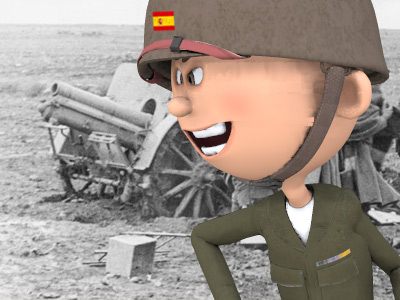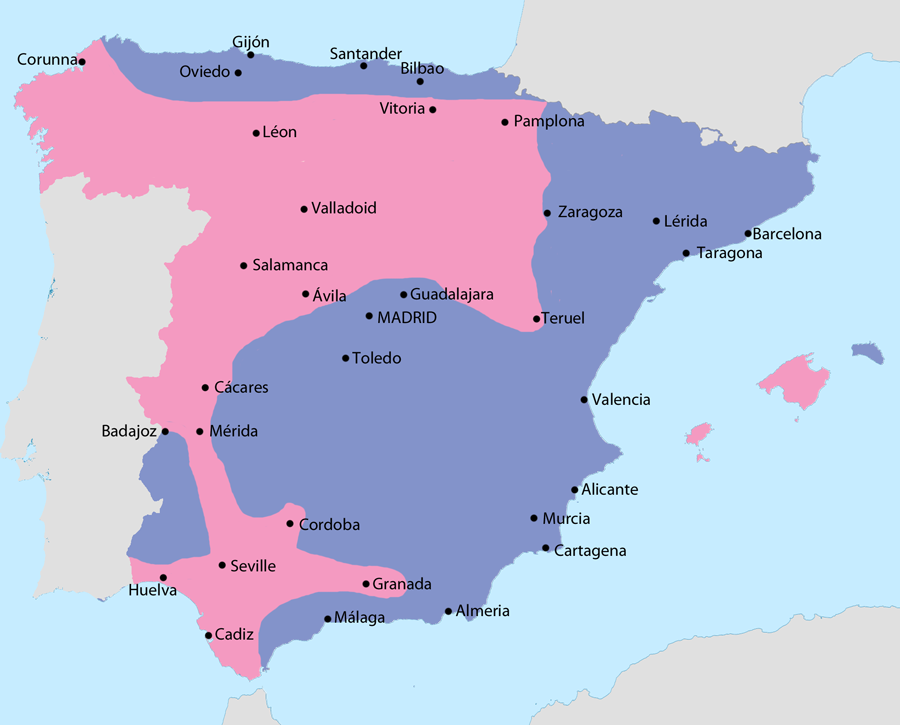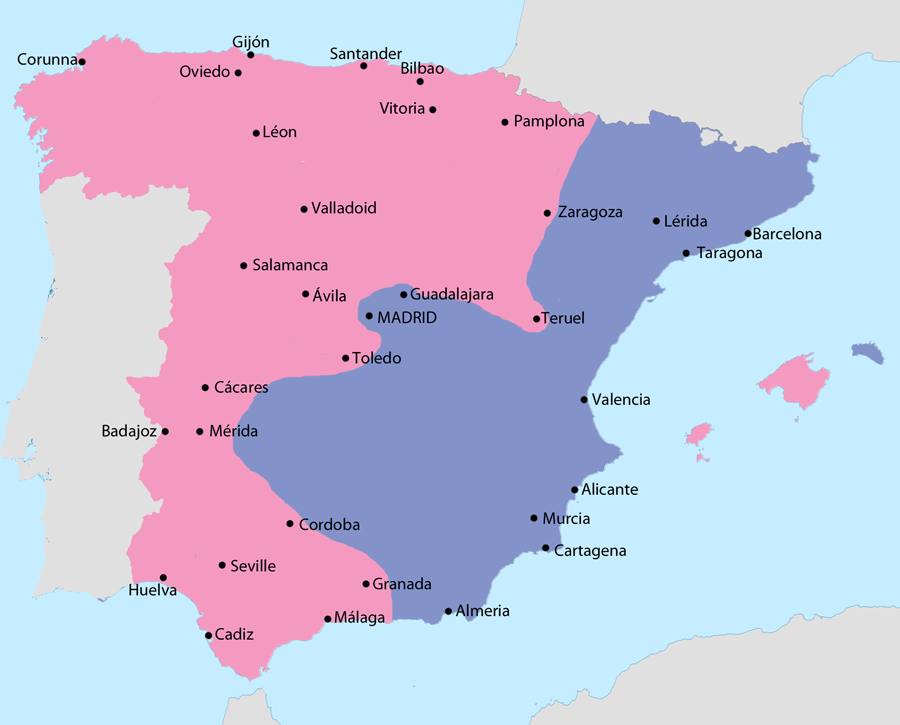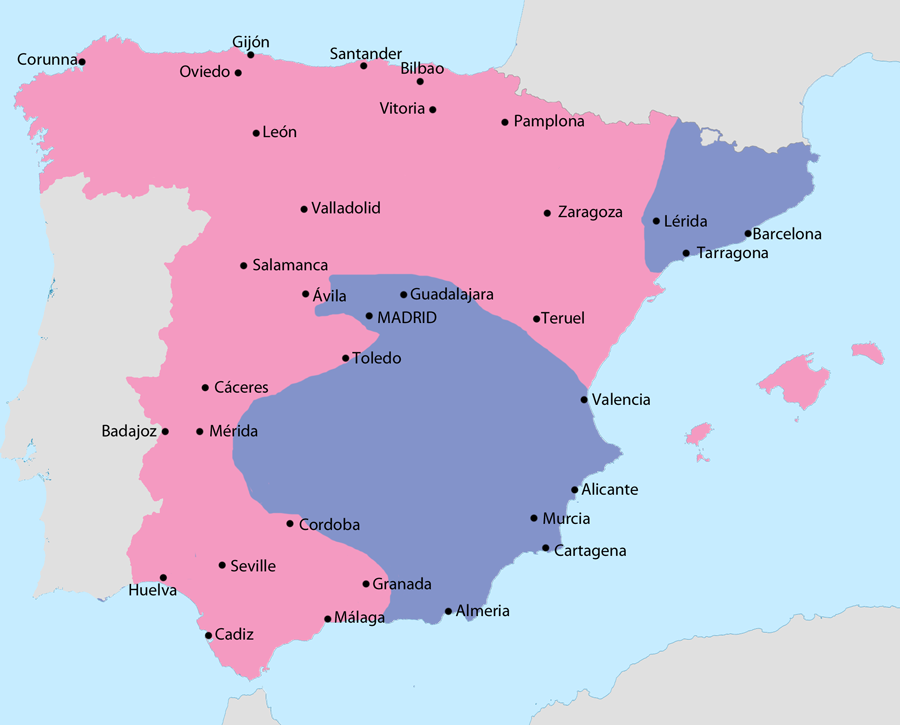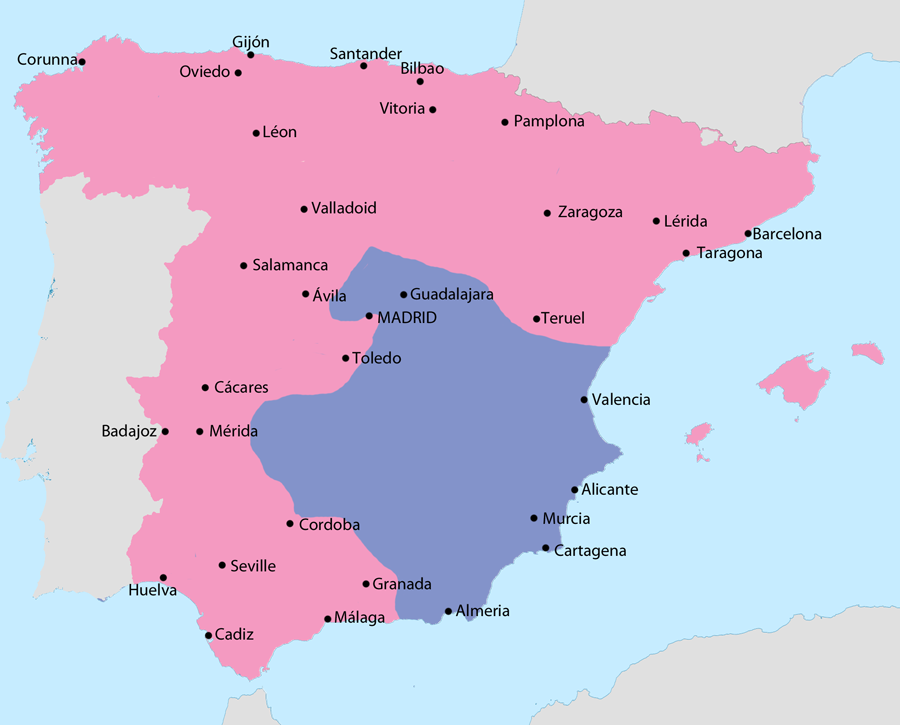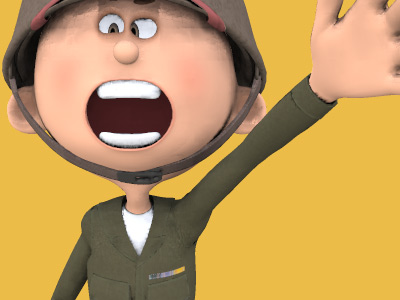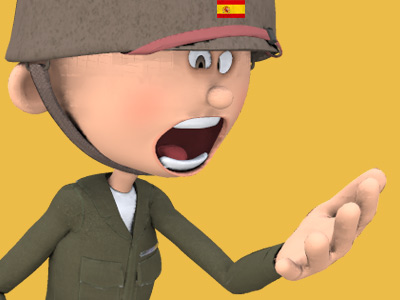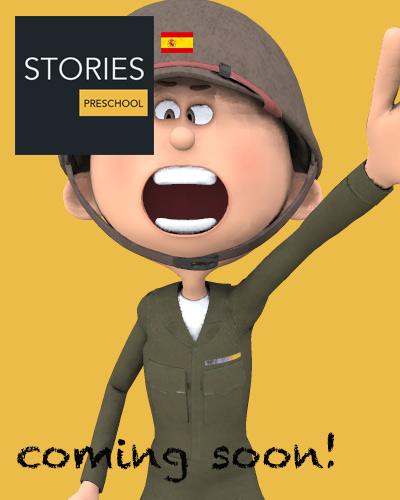Spanish Civil War (1936 to 1939)
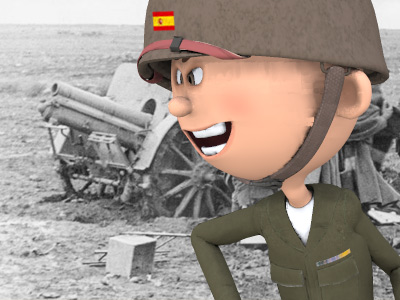
Combatants
The war was cast by Republican sympathizers as a struggle between tyranny and freedom, and by Nationalist supporters as communist and anarchist "red hordes" versus "Christian civilization". Nationalists also claimed they were bringing security and direction to an ungoverned and lawless country. Spanish politics, especially on the left, were quite fragmented, since socialists and communists supported the republic. During the republic, anarchists had mixed opinions, but major groups opposed the Nationalists during the Civil War. The Conservatives, in contrast, were united by their fervent opposition to the Republican government and presented a more unified front.
The coup divided the armed forces fairly evenly. One historical estimate suggests that there were some 87,000 troops loyal to the government and some 77,000 joining the insurgency, though some historians suggest that the Nationalist figure should be revised upwards and that it probably amounted to some 95,000.
During the first few months both armies were joined in high numbers by volunteers; unfortunately, there are no scholarly estimates available. Starting August both sides launched own and similarly scaled conscription schemes, resulting in further massive growth of their armies. Finally, final months of 1936 recorded arrival of foreign troops, International Brigades joining the Republicans and Italian CTV, German Legion Condor and Portuguese Viriatos joining the Nationalists. The result was that in April 1937 there were some 360,000 soldiers in the Republican ranks and some 290,000 in the Nationalist ones.
The armies kept growing. The principal source of manpower was conscription; both sides continued and expanded their schemes, the Nationalists drafting somewhat more aggressively, and there was little room left for volunteering. Foreigners hardly contributed to further growth; on the Nationalist side the Italians scaled down their engagement, while on the Republican side influx of new interbrigadistas hardly made up for losses, suffered by these units on the front. At the turn of 1937/1938 both armies achieved numerical parity and equalled about 700,000 each.
Throughout 1938 the principal if not exclusive source of new men was draft; at this stage it was the Republicans who conscripted more aggressively. In mid-year, just prior to the Battle of Ebro, the Republicans achieved their all-time high commanding the army of slightly above 800,000 people; this was already no match for the Nationalists, who numbered 880,000. The Battle of Ebro, fall of Catalonia and collapsing discipline produced massive shrinking of the Republican troops. In late February 1939 their army was 400,000 compared to more than double that number of Nationalists. In the moment of their final victory, the latter commanded over 900,000 troops.
The total number of Spaniards serving in the Republican forces was officially stated as 917,000; latest scholarly work estimates the actual number as "well over 1 million men", though earlier historiographical studies claimed the Republican total (including foreigners) of 1.75m. The total number of Spaniards serving in the Nationalist units is currently estimated at "nearly 1 million men", though earlier works claimed (foreigners included) the total of 1.26m.
Advertisement

These books are available for download with iBooks on your Mac or iOS device, and with iTunes on your computer. Books can be read with iBooks on your Mac or iOS device.

These books are available for download with iBooks on your Mac or iOS device, and with iTunes on your computer. Books can be read with iBooks on your Mac or iOS device.
( Click image to enlarge)
Republicans
Only two countries openly and fully supported the Republic: Mexico and the USSR. From them, especially the USSR, the Republic received diplomatic support, volunteers, and the ability to purchase weapons. Other countries remained neutral, said neutrality being a great source of distress to the intelligentsia in the United States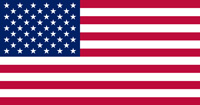 The United States of America (U.S.A. or USA), commonly known as the United States (U.S. or US) or America, is a country in North America. It is the world's third-largest country by both land and total area. The United States shares land borders with Canada to its north and with Mexico to its south. The national capital is Washington, D.C., and the most populous city and financial center is New York City. and United Kingdom
The United States of America (U.S.A. or USA), commonly known as the United States (U.S. or US) or America, is a country in North America. It is the world's third-largest country by both land and total area. The United States shares land borders with Canada to its north and with Mexico to its south. The national capital is Washington, D.C., and the most populous city and financial center is New York City. and United Kingdom The United Kingdom of Great Britain and Northern Ireland, commonly known as the United Kingdom (UK) or Britain, is a country in Europe, off the north-western coast of the continental mainland. It comprises England, Scotland, Wales and Northern Ireland. The UK became the world's first industrialised country and was the world's foremost power during the 19th and early 20th centuries., and to a lesser extent in other European countries and to Marxists worldwide. This distress led to the International Brigades, thousands of foreigners of all nationalities who voluntarily went to Spain to aid the Republic in the fight; they meant a great deal to morale but militarily were not very significant.
The United Kingdom of Great Britain and Northern Ireland, commonly known as the United Kingdom (UK) or Britain, is a country in Europe, off the north-western coast of the continental mainland. It comprises England, Scotland, Wales and Northern Ireland. The UK became the world's first industrialised country and was the world's foremost power during the 19th and early 20th centuries., and to a lesser extent in other European countries and to Marxists worldwide. This distress led to the International Brigades, thousands of foreigners of all nationalities who voluntarily went to Spain to aid the Republic in the fight; they meant a great deal to morale but militarily were not very significant.
The Republic's supporters within Spain ranged from centrists who supported a moderately-capitalist liberal democracy to revolutionary anarchists who opposed the Republic but sided with it against the coup forces. Their base was primarily secular and urban but also included landless peasants and was particularly strong in industrial regions like Asturias, the Basque country, and Catalonia.
This faction was called variously leales "Loyalists" by supporters, "Republicans", the "Popular Front", or "the government" by all parties; and/or los rojos "the Reds" by their opponents. Republicans were supported by urban workers, agricultural labourers, and parts of the middle class.
The conservative, strongly Catholic Basque country, along with Galicia and the more left-leaning Catalonia, sought autonomy or independence from the central government of Madrid. The Republican government allowed for the possibility of self-government for the two regions, whose forces were gathered under the People's Republican Army (Ejército Popular Republicano, or EPR), which was reorganized into mixed brigades after October 1936.
A few well-known people fought on the Republican side, such as English novelist George Orwell (who wrote Homage to Catalonia (1938), an account of his experiences in the war) and Canadian thoracic surgeon Norman Bethune, who developed a mobile blood-transfusion service for front-line operations. Simone Weil added herself for a while to the anarchist columns of Buenaventura Durruti, though fellow fighters feared she might inadvertently shoot them because she was shortsighted, and tried to avoid taking her on missions. By the account of her biographer Simone Petrement, Weil was evacuated from the front after a matter of weeks because of an injury sustained in a cooking accident.
Nationalists
The Nacionales or Nationalists — also called "insurgents", "rebels", or, by opponents, Franquistas or "fascists" (see: the Nationalist faction) — feared national fragmentation and opposed the separatist movements. They were chiefly defined by their anti-communism, which galvanized diverse or opposed movements like falangists and monarchists. Their leaders had a generally wealthier, more conservative, monarchist, landowning background.
The Nationalist side included the Carlists and Alfonsists, Spanish nationalists, the fascist Falange, and most conservatives and monarchist liberals. Virtually all Nationalist groups had strong Catholic convictions and supported the native Spanish clergy. The Nationals included the majority of the Catholic clergy and practitioners (outside of the Basque region), important elements of the army, most large landowners, and many businessmen.
One of the rightists' principal motives was to confront the anti-clericalism of the Republican regime and to defend the Catholic Church, which had been targeted by opponents, including Republicans, who blamed the institution for the country's ills. The Church was against the Republicans' liberal principles, which were fortified by the Spanish Constitution of 1931. Prior to the war, during the Asturian miners' strike of 1934, religious buildings were burnt and at least 100 clergy, religious civilians, and pro-Catholic police were killed by revolutionaries.
Franco had brought in the mercenaries of Spain's colonial Army of Africa (Spanish: Ejército de África or Cuerpo de Ejército Marroquí) and reduced the miners to submission by heavy artillery attacks and bombing raids. The Spanish Legion committed atrocities—many men, women and children were killed, and the army carried out summary executions of leftists. The repression in the aftermath was brutal. In Asturias, prisoners were tortured.
Articles 24 and 26 of the 1931 constitution had banned the Society of Jesus. This proscription deeply offended many within the conservative fold. The revolution in the Republican zone at the outset of the war, in which 7,000 clergy and thousands of lay people were killed, deepened Catholic support for the Nationalists. The Moroccan Fuerzas Regulares Indígenas joined the rebellion and played a significant role in the civil war.
Other factions
Catalan and Basque nationalists were not univocal. Left-wing Catalan nationalists sided with the Republicans, while Conservative Catalan nationalists were far less vocal in supporting the government due to anti-clericalism and confiscations occurring in areas within its control. Basque nationalists, heralded by the conservative Basque Nationalist Party, were mildly supportive of the Republican government, although some in Navarre sided with the uprising for the same reasons influencing conservative Catalans. Notwithstanding religious matters, Basque nationalists, who were for the most part Catholic, generally sided with the Republicans, although the PNV, Basque nationalist party, was reported passing the plans of Bilbao defenses to the nationalists, in an attempt to reduce the duration and casualties of siege.
HISTORY
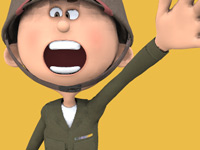
RESOURCES
This article uses material from the Wikipedia article "Spanish Civil War", which is released under the Creative Commons Attribution-Share-Alike License 3.0.
© Stories Preschool. All Rights Reserved.
